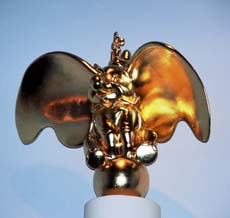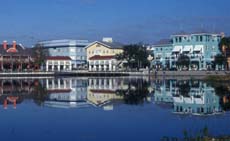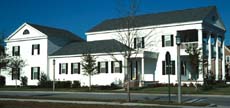index
Disney and Celebration
click on images for full-size:







Could a Disney character be an angel?

The Celebration Cinema

Celebration downtown across the lake

Townhouses in Celebration

Live/work apartments in Celebration

Side view of a Celebration house on a main street
Discussions of Celebration often make much of its sponsorship by Disney, and its supposed resemblance to living in a theme park. Some residents moved there with the hope that the Disney's backing would assure the community effective institutions and schools, and financial security. However, as Ross recounts, such hopes faded as corporate involvement was reduced and the county school board refused special status for the Celebration school. Still, the connection to the nearby theme parks remains. Partly this is because Disney money had provided Celebration with a larger already built up downtown area, even if it does not contain many stores catering to daily needs. Other New Urbanist developments have to grow their own downtowns, and it is a slow process. Also, the Celebration downtown borders a small artificial lake, which is a common spatial arrangement in most of Orlando's theme parks. When I visited Celebration I stayed in nearby Kissimmee, which is a town pulled in several directions: its agricultural past, its own modest downtown, a huge strip lodging and servicing Disney tourists, and, as something of an afterthought, its neighbor Celebration. No piece of this mix stands by itself. One episode highlighted this mix of roles and place norms for me. I heard screams when I was walking in the most expensive area of Celebration, near where Celebration borders on Old Town, a tourist collection of shops and small attractions organized as an outdoor steet mall. "Old Town's low-rent version of the bygone days is a mixed bag. Tattoo studios and psychic readers keep company with nostalgia emporiums and video arcades." (Ross 1999, 274) It also includes a thrill ride called the Sky Coaster, so that rising above the smart stylized Celebration houses and sedate streets are two twenty-story towers where you can be strapped into a harness, hauled up to the top of one tower while a cable connects you to the top of the other. Then you are dropped, to swing in a huge arc down and up, then down and up again, coming to a gradual stop. As Ross remarks, real estate agents find it "no easy task to steer a sales pitch for luxury homes around the spectacle of inebriated tourists undergoing near-death experiences." (275) When I stopped in at Old Town I watched as three smug and cheerful girls were strapped into the device, lifted to the top, and then, while their proud parents were video-taping the experience, screamed "Hoohh-lyyy Shiiit!!" as they plummeted downwards. This intensity doesn't fit the suburban idyll, but the juxtaposition of Celebration and Old Town mirrors the real linkages of the region. In the center of Celebration you get away from the strip, but at the edges the linkages become more obtrusive. The links and contrasts puncture the image Celebration wants to sell, but they set that image and its values in a fuller context. This context and linkage does not negate the values, but it does refuse them supremacy and dominance. The unity exists but within a context and field that it does not control.